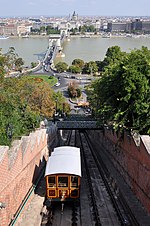Carmelite Monastery of Buda

Carmelite Monastery of Buda (natively: Karmelita kolostor) is a former Catholic monastic residence and the current seat of the Prime Minister of Hungary. The monastery was built in 1736 by the Carmelite order on the former site of a mosque that was destroyed in 1686 during the siege that liberated Buda from Ottoman occupation. The order received the real estate in 1693 and completed the new monastery and church by 1736, but it was consecrated only in 1763. Two decades later, Emperor Joseph II disbanded the order and converted the property into a theater by imperial order in 1786, "for the delectation of high-ranking court officials". Some notable performances included Beethoven and the premiere of Bánk Bán.
Excerpt from the Wikipedia article Carmelite Monastery of Buda (License: CC BY-SA 3.0, Authors, Images).Carmelite Monastery of Buda
Színház utca, Budapest Castle District
Geographical coordinates (GPS) Address External links Nearby Places Show on map
Geographical coordinates (GPS)
| Latitude | Longitude |
|---|---|
| N 47.498327777778 ° | E 19.037811111111 ° |
Address
Karmelita kolostor
Színház utca 5-9
1014 Budapest, Castle District
Hungary
Open on Google Maps











